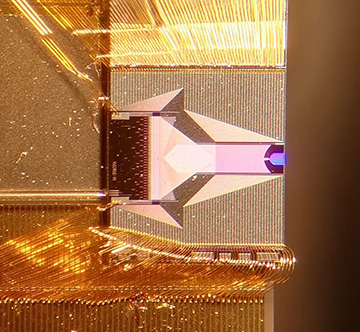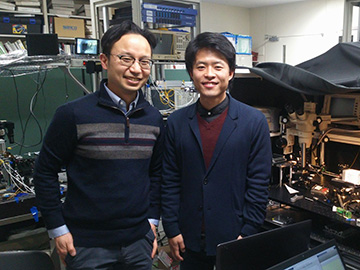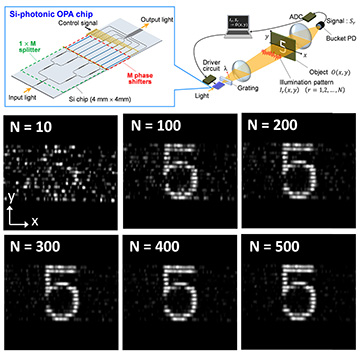
An optical phased array including 128 electrically controlled phase shifters, packed on a 4×4-mm silicon photonic chip, could offer a way to bring fast, low-overhead ghost imaging to the chip scale, for applications such as lidar and smartphone imaging. [Image: Takuo Tanemura, University of Tokyo]
A research team in Japan has found a way to pack the equipment for so-called ghost imaging—a cutting-edge imaging technique that, in the lab, typically requires bulky spatial light modulators and other optical components—onto a 4×4-mm silicon photonic chip (Opt. Express, doi: 10.1364/OE.27.003817). The researchers believe that the setup, if it can be scaled up commercially, could find applications in low-cost, fast imaging systems for lidar, smartphone-based imaging and more.
Fast but bulky
In “classical” ghost imaging, an object is imaged using light that has never physically interacted with the object—hence the “ghost” in the name (see “Ghost Imaging,” OPN, October 2016). Instead, a series of random optical patterns is split and shone on both the object and an imaging camera, and the analog intensity level of the transmitted or reflected light from the object is picked up in a single-pixel detector.
For each random pattern shone in succession on the object, the intensity level in the single-pixel detector essentially integrates the overlap between the random pattern and the light from the imaged object. Hence, by weighting each correlated random pattern at the camera end by the intensity level signal, and computationally summing the weighted random patterns, an image of the object emerges at the camera.
Ghost imaging has already been proposed or implemented to boost imaging speed in a variety of application areas, ranging from multispectral imaging and microscopy to counting cells in flow-cytometry systems. Further, because it can operate using low-cost, fast-responding single-pixel detectors, and can leverage compressed-sending techniques to reduce the number of required measurements, the scheme has particular promise at nonvisible wavelength ranges, where conventional detector arrays can be costly.
In the view of some researchers, those attributes could make ghost imaging a natural fit for lidar systems in particular. The drawback of ghost-imaging systems, however, lies in the size of some of their components—particularly the bulky, relatively slow spatial light modulators (SLMs) commonly used to create the required series of random optical images used in the technique.
Optical phased array

Team leader Takuo Tanemura (left) and first author Yusuke Kohno in the lab. [Image: Takuo Tanemura, University of Tokyo]
To get past the bulk problem, the team at the University of Tokyo, led by OSA member Takuo Tanemura, looked at an alternative to SLMs for creating the random optical images required for ghost imaging: a phased array of 128 tiny phase shifters, packed onto a chip with a 4×4-mm footprint. The team took advantage of previous work developing such phased arrays for beam steering and projection, which established that the setup can play well with CMOS manufacturing processes.
In the chip setup, input light from a 1550-nm laser, coupled into the array via a lensed fiber, is split into 128 waveguides and piped into the phase-shifting elements of the array. Each individual phase shifter can be electrically controlled, allowing rapid creation of a series of random speckled patterns, at refresh rates faster than the few-frame-per-second rates of SLMs such as state-of-the-art digital micromirror devices (DMDs).
The random pattern is both sent to a computer and shone on the object to be imaged, and the transmitted light intensity is read using a bucket photodetector at the other end. The ghost imaging happens when the computer reconstructs the object image from multiple correlated random patterns, weighted by the intensity signal from the photodiode.
Toward cheaper lidar
Top: Schematic view of device and setup (simplified to show only eight waveguides, rather than the 128 on the actual device). Bottom: By sweeping across a range of wavelengths, the team was able to image a 2-D object using 200 weighted random patterns. [Images: Kohno et al., Opt. Express, doi: 10.1364/OE.27.003817] [Enlarge image]
Using the setup, the team was able to image a 1-D slit pattern “with a spatial resolution comparable to that of conventional beam steering,” according to the authors. The researchers also were able to image a 2-D pattern (the number “5” from a standard 1951 USAF resolution target) by sweeping the wavelength of the tunable laser through a series of 200 random patterns by the array.
While the proof-of-concept device’s switching rate is limited to around every 20 microseconds, or 50 kHz, the team believes that the use of carrier-depletion-type, electro-optic phase shifters in the array could kick that up to ultra-high switching rates on the order of 10 GHz. The team also points out that advances in integrating active devices such as laser diodes and optical amplifiers onto silicon chips opens the possibility of a completely integrated ghost-imaging system—with light source, phase-shifting array and other components all packed on a single chip.
“This type of imaging device could be particularly useful for lidar, which currently produces 3-D images using a bulky mechanical mirror to steer a laser beam,” team leader Tanemura noted in a press release accompanying the research. “It is estimated that the cost, size and response time of lidar needs to be reduced by one to two orders of magnitude to be widely deployed in non-luxury, mass-market cars. A chip-scale ghost imaging device could accomplish this.”

